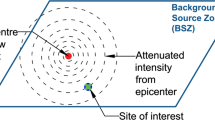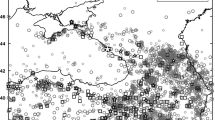Abstract
The development of the new seismic hazard map of metropolitan Tehran is based on probabilistic seismic hazard computation using the non-Poisson recurrence time model. For this model, two maps have been prepared to indicate the earthquake hazard of the region in the form of iso-acceleration contour lines. They display the non-Poisson probabilistic estimates of peak ground accelerations over bedrock for 10 and 63 % probability of exceedance in 50 years. To carry out the non-Poisson seismic hazard analysis, appropriate distributions of interoccurrence times of earthquakes were used for the seismotectonic provinces which the study region is located and then the renewal process was applied. In order to calculate the seismic hazard for different return periods in the probabilistic procedure, the study area encompassed by the 49.5–54.5°E longitudes and 34–37°N latitudes was divided into 0.1° intervals generating 1,350 grid points. PGA values for this region are estimated to be 0.30–0.32 and 0.16–0.17 g for 10 and 63 % probability of exceedance, respectively, in 50 years for bedrock condition.




Similar content being viewed by others
References
Aki K (1956) Some problems in statistical seismology. Zisin 8:205–228
Ambraseys NN, Douglas J, Sarma SK, Smit PM (2005) Equations for the estimation of strong ground motions from shallow crustal earthquakes using data from Europe and the Middle East: horizontal peak ground acceleration and spectral acceleration. Bull Earthq Eng 3(1):1–53. doi:10.1007/s10518-005-0183-0
Anagnos T, Kiremidjian AS (1984) Stochastic time-predictable model for earthquake occurrences. Bull Seismol Soc Am 74(6):2593–2611
Bak P, Christensen K, Danon L, Scanlon T (2002) Unified scaling law for earthquakes. Phys Rev Lett 88:178501
Baker C, Jackson J, Priestley K (1993) Earthquakes on the Kazerun Line in the Zagros Mountains of Iran: strike-slip faulting within a fold-and-thrust belt. Geophys J Int 115(1):41–61. doi:10.1111/j.1365-246X.1993. tb05587.x
Berberian M (1981) Active faulting and tectonics of Iran. In: Gupta HK, Delany FM (eds) Zagros, Hindu Kush, Himalaya: geodynamics evaluation. American Geophysical Union, Washington D.C., Geodynamic Ser. 3, 33–69, doi: 10.1029/GD003p0033
Berberian M (1983) Contribution to the seismotectonics of Iran (part IV). Geol Surv Iran Rep 52
Berberian M, Qorashi M (1988) Iranian cities in devilish circle of earthquake, Adinneh, 31, 62–65 (in Persian). Monstrous
Berberian M, Yeats RS (1999) Patterns of historical earthquake rupture in the Iranian Plateau. Bull Seismol Soc Am 89(1):120–139
Copley A, Jackson J (2006) Active tectonics of the Turkish-Iranian Plateau. Tectonics 25:TC6006. doi:10.1029/2005TC001906
Cornell CA (1968) Engineering seismic risk analysis. Bull Seismol Soc Am 58(5):1583–1606
Corral A (2004) Long-term clustering, scaling, and universality in the temporal occurrence of earthquakes. Phys Rev Lett 92:108501
Der Kiureghian A, Ang AH-S (1977) A fault rupture model for seismic risk analysis. Bull Seismol Soc Am 67(4):1173–1194
Gao M (1988) Discussion on annual occurrence rates. Recent Dev World Seismol 1:1–5
Ghodrati Amiri G, Motamed R, Rabet Es-haghi H (2003) Seismic hazard assessment of metropolitan Tehran, Iran. J Earthq Eng 7(3):347–372. doi:10.1080/13632460309350453
Hasumi T, Akimoto T, Aizawa Y (2009) The Weibull-log Weibull distribution for interoccurrence times of earthquakes. Physica A 388:491–498
Hasumi T, Chen C, Akimoto T, Aizawa Y (2010) The Weibull-log Weibull transition of interoccurrence time for synthetic and natural earthquakes. Tectonophysics 485B:9–16
He H, Zhang Y, Zhou B (1994) Delineation of potential seismic sources in continent of China. In: Proc. Workshop on Implementation of GSHAP in Central and Southern Asia, Beijing, China, pp 169–183
Jackson J, McKenzie D (1984) Active tectonics of the Alpine-Himalayan Belt between western Turkey and Pakistan. Geophys J Roy Astron Soc 77(1):185–264. doi:10.1111/j.1365-246X.1984.tb01931.x
Jackson J, McKenzie D (1988) The relationship between plate motions and seismic moment tensors, and the rates of active deformation in the Mediterranean and the Middle East. Geophys J Int 93(1):45–73. doi:10.1111/j.1365-246X.1988.tb01387.x
Jackson J, Haines J, Holt W (1995) The accommodation of Arabia–Eurasia plate convergence in Iran. J Geophys Res 100(B8):15205–15219. doi:10.1029/95JB01294
Jackson J, Priestley K, Allen M, Berberian M (2002) Active tectonics of the South Caspian Basin. Geophys J Int 148(2):214–245. doi:10.1046/j.1365- 246X.2002.01588.x
Kayabali K (2002) Modeling of seismic hazard for Turkey using the recent neotectonic data. Eng Geol 63(3–4):221–232. doi:10.1016/S0013-7952(01)00082-5
Khodabin M, Ahmadabadi A (2010) Some properties of generalized gamma distribution. Math Sci QJ 4:9–28
Kijko A, Funk CW (1994) The assessment of seismic hazards in mines. J S Afr Inst Min Metall 179–185
Kijko A, Sellevoll MA (1992) Estimation of earthquake hazard parameters from incomplete data files. Part II. Incorporation of magnitude heterogeneity. Bull Seismol Soc Am 82(1):120–134
Kiremidjian AS, Anagnos T (1984) Stochastic slip-predictable model for earthquake occurrences. Bull Seismol Soc Am 74(2):739–755
Lennartz S, Livina VN, Bunde A, Havlin S (2008) Long-term memory in earthquakes and the distribution of interoccurrence times. Europhys Lett 81:69001
Matthews MV, Ellsworth WL, Reasenberg PA (2002) A Brownian model for recurrent earthquakes. Bull Seismol Soc Am 92:2233–2250
Mirzaei N (1997) Seismic zoning of Iran. Ph.D. dissertation in Geophysics, Beijing: Institute of Geophysics, State Seismological Bureau
Mirzaei N, Gao M, Chen YT (1997a) Seismicity in major seismotectonic provinces of Iran. Earthq Res China 11(4):35–360
Mirzaei N, Gao M, Chen YT, Wang J (1997b) A uniform catalog of earthquakes for seismic hazard assessment in Iran. Acta Seismol Sin 10:713–726
Mirzaei N, Gao M, Chen YT (1998) Seismic source regionalization for seismic zoning of Iran: major seismotectonic provinces. J Earthq Predict Res 7:465–495
Mirzaei N, Gao M, Chen YT (1999) Delineation of potential seismic sources for seismic zoning of Iran. J Seismol 3(1):17–30. doi:10.1023/A:1009737719013
Nowroozi AA (1971) Seismotectonics of the Persian plateau, eastern Turkey, Caucasus, and Hindu–Kush regions. Bull Seismol Soc Am 61(2):317–341
Nowroozi AA (1972) Focal mechanism of earthquakes in Persia, Turkey, West Pakistan, and Afghanistan and plate tectonics of the Middle East. Bull Seismol Soc Am 62(3):823–850
Nowroozi AA (1976) Seismotectonic provinces of Iran. Bull Seismol Soc Am 66(4):1249–1276
Priestley K, Baker C, Jackson J (1994) Implications of earthquake focal mechanism data for the active tectonics of the south Caspian Basin and surrounding regions. Geophys J Int 118(1):111–141. doi:10.1111/j.1365- 246X.1994.tb04679.x
Ross SM (1983) Stochastic processes. Wiley, New York
Shah HC, Movassate M, Zsutty TC (1976) Seismic risk analysis for California state water project. The John A. Blume Earthquake Engineering Center, Department of Civil and Environmental Engineering, Stanford University, Rep. 22
Shi Z, Yan J, Gao M (1992) Research on the principles and methodology of seismic zonation: results of the trials in North China. Acta Seismol Sin 5(2):305–314. doi:10.1007/BF02651697
Shoja-Taheri J, Niazi M (1981) Seismicity of the Iranian plateau and bordering regions. Bull Seismol Soc Am 71(2):477–489
Stöcklin J (1968) Structural history and tectonics of Iran: a review. Bull Am Assoc Petrol Geol 52(7):1229–1258
Stöcklin J (1974) Northern Iran: Alborz Mountains. Geological Society, London, Special Publications 4:213–234. doi:10.1144/GSL.SP.2005.004.01.12
Student HH (1997) Assessing the seismic hazard in Charleston south Carolina: comparisons among statistical models. M.Sc. dissertation in Geophysics, Blacksburg, Virginia: Polytechnic Institute and State University
Tahernia N, Khodabin M, Mirzaeai N (2011) Mixed model for interoccurrence times of earthquakes based on the expectation-maximization algorithm. Acta Geophys 59(5):872–890. doi:10.2478/s11600-011-0028-y
Tahernia N, Khodabin M, Mirzaeai N, Eskandari-Ghadi M (2012) Statistical models of interoccurrence times of Iranian earthquakes on the basis of information criteria. J Earth Syst Sci 121(2):463–474
Talebian M, Jackson J (2004) A reappraisal of earthquake focal mechanisms and active shortening in the Zagros mountains of Iran. Geophys J Int 156(3):506–526. doi:10.1111/j.1365-246X.2004.02092.x
Tatar M, Hatzfeld D, Ghafory-Ashtiany M (2004) Tectonics of the Central Zagros (Iran) deduced from microearthquake seismicity. Geophys J Int 156(2):255–266. doi:10.1111/j.1365-246X.2003.02145.x
Vere-Jones D (1970) Stochastic models for earthquake occurrence. J Roy Stat Soc B (Methodol) 32(1):1–62
Walker R, Jackson J (2004) Active tectonics and late Cenozoic strain distribution in central and eastern Iran. Tectonics 23:TC5010. doi:10.1029/2003TC001529
Yan J (1993) Principals and methods to determine spatial distribution function. In: Proc. PRC/USSR Workshop on Geodynamics and Seismic and Risk Assessment, Beijing, China, pp 159–167
Ye H, Zhou Y, Zhou Q, Yang W, Chen G, Hao C (1993) Study on potential seismic sources for seismic zonation and engineering seismic hazard analysis in continental areas. In: Continental Earthquakes, IASPEI Publication Series for the IDNDR 3, 473–478
Zhang Y (1993) Principles and methods on delineation of potential earthquake source area. In: Proc. PRC/USSR Workshop on Geodynamics and Seismic Risk Assessment, Beijing, China, pp 201–207
Author information
Authors and Affiliations
Corresponding author
Rights and permissions
About this article
Cite this article
Tahernia, N., Khodabin, M. & Mirzaei, N. Non-Poisson probabilistic seismic hazard assessment. Arab J Geosci 7, 3259–3269 (2014). https://doi.org/10.1007/s12517-013-0930-5
Received:
Accepted:
Published:
Issue Date:
DOI: https://doi.org/10.1007/s12517-013-0930-5




